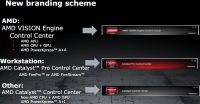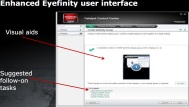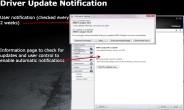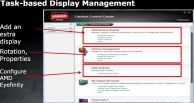The Catalyst Control Center is likely one of the more talked about pieces of software in our fine industry, and that's not only because it's one of the longest running ones. Being on the receiving end of some rather burning hatred, as well as some moderate love, this old chap has had its share of battles throughout the years, and while trolling it over its .Net nature (because UIs absolutely have to be coded in at least arcane pointer-laden C if not ASM proper, for that last bit of performance!) is a rather trendy sport, it's quite hard to ignore the fact that it does seem to follow an evolutionary path with some determination...which brings us to today's topic, which is another step in this process.
As you've probably guessed (and if you didn't, our less late brethren have made sure that you're informed), we're talking about Project Mjölnir, or at least part of it. We're not sure why taking a hammer to a delicate piece of technology like a GPU seems like a great idea, but we're hardly the ones to argue about codenames, given what we tend to use internally. Basically, Thor's mighty hammer is supposed to encompass quite a few overall improvements to ATI's driver suite, from CCC additions/extensions to performance enhancements and a rebrand to go along and underline AMD's arrow piercing ATI's read heart in the last great internal battle of great rebranding.
The CCC additions, at least in the build we got to see, amount to a more intuitive/helpful UI for Display Management in general, and Eyefinity in particular and a new tab that deals with driver updates, providing notifications when newer drivers are available and allowing for both automated and manual update checking.
Our feeling is that ATI is moving its driver control UI into the future that is now that is Fusion era, preparing it for the greater exposure it's bound to get as CPU-GPU sammiches...err, we mean APUs (that's Accellerated Processing Units, yo!), start being used en-masse. It's probable that the end-goal is to have a nice and not at all dangerous UI, fit for consumption by the less tech savvy users, that allows messing with both the CPU and the GPU, when the AMD-ATI matching is present in a system. Time will tell if we're right.
That being said, we're willing to bet you don't come to Beyond3D to hear a lot about UI additions, but rather for technical quips. Whilst the breadth of our driver research will be presented in a future article, we can share a few preliminary observations: the new drivers we got seemed a better fit for Cayman, at least in our case, with some mild compiler fixes/tweaks being apparently in place, and some bugs we could trigger now fixed. We still see some problems with our use of texture arrays in the Beyond3D Testing Suite, although it may be our fault. It's worth noting though that the competition has no problem with our code, and that we're not doing anything fancy.
Summing up, the upcoming 11.4s should be a rather decent effort from ATI, if what we're seeing now is any indication, and we believe that the next hammer strikes should be good too, bar any incredible mishaps happening in the interim.
Looking a bit forward, the next big-ish thing we expect, which isn't present in the driver build we got but should be coming this year, is proper support for DX11 multithreaded rendering aka angry usage of deferred contexts. This should bring some nice improvements, but from what we gather a proper implementation is hard to bring out, since MS and IHVs seem to be at odds what qualifies as a good idea/proper, at least in certain regards. Suffice to say that when it comes, we'll be ready for it with proper testing tools in place (they're heer now actually).




